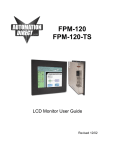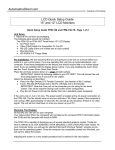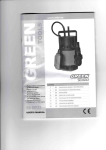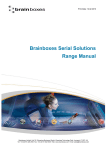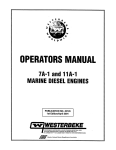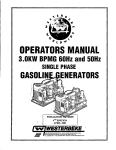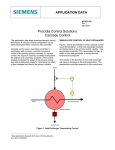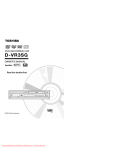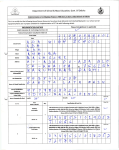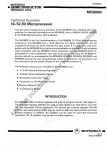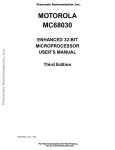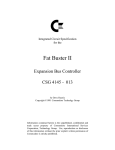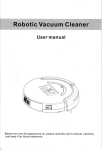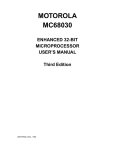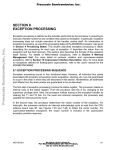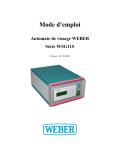Download MC68030 Second-Generation 32-Bit .. Enhanced Microprocessor
Transcript
Order this document
by MC68030/D
MOTOROLA
-
SEMICONDUCTOR
TECHNICAL DATA
MC68030
Technical Summary
Second-Generation 32-Bit
.. Enhanced Microprocessor
The MC68030 is a 32-bit virtual memory microprocessor that integrates the
functionality of an MC68020 core with the added capabilities of an on-chip
paged memory management unit (MMU) and an on-chip 256-byte data cache.
Additionally, the MC68030 is enhanced with multiple internal address and data
buses as well as a more versatile bus controller that can support two-clock bus
accesses and one-clock burst accesses to maximize performance. The rich instruction set and addressing mode capabilities of the MC68020 have been
maintained, allowing a clear migration path for M68000 systems. For detailed
information on the MC68030, refer to MC68030UM/AD, MC68030 Enhanced
32-Bit Microprocessor User's Manual.
The main features of the MC68030 are as follows:
• Object-Code Compatible with the MC68020 and Earlier M68000 Microprocessors
• Complete 32-Bit Nonmultiplexed Address and Data Buses
• 16 32-Bit General-Purpose Data and Address Registers
• Two 32-Bit Supervisor Stack Pointers and 10 Special-Purpose Control Registers
• 256-Byte Instruction Cache and 256-Byte Data Cache Can Be Accessed
Simultaneously
• Paged MMU Translates Addresses in Parallel with Instruction Execution
• Two Transparent Segments Allow Untranslated Blocks To Be Defined for
Systems That Transfer Large Blocks of Data to Predefined Addresses i.e., Graphics Applications
• Pipelined Architecture with Increased Parallelism Allows Accesses from
Internal Caches to Occur in Parallel with Bus Transfers and Instruction
Execution To Be Overlapped
This document contains information on a new product. Specifications and information hert::m are SUDJeCI IO cnange Wltnout notice.
MOTOROLA _
©MOTOROLA INC., 1991
Rev. 3
• Enhanced Bus Controller Supports Asynchronous Bus Cycles, (three clocks
minimum), Synchronous Bus Cycles, (two clocks minimum), and Burst
Data Transfers (one cock minumum), all to the Physical Address Space
• Dynamic Bus Sizing Supports 8-/16-/32-Bit Memories and Peripherals
• Complete Support for Coprocessors with the M68000 Coprocessor Interface
• Internal Status Indication for Hardware Emulation Support
• 4-Gbyte Direct Addressing Range
• Implemented in Motorola's HCMOS Technology That Allows CMOS and
HMOS (High-Density NMOS) Gates To Be Combined for Maximum Speed,
Low Power, and Small Die Size
• Processor Speeds Beyond 20 MHz
INTRODUCTION
The MC68030 is an integrated processor that incorporates the capabilities of
the MC68020 microprocessor, the memory management structure defined by
the MC68851 paged memory management unit (PMMU), data cache, an instruction cache, and an improved bus controller on one VLSI device. It maintains
the 32-bit registers available with the entire M68000 Family as well as the
32-bit address and data paths, rich instruction set, versatile addressing modes,
and flexible coprocessor interface provided with the MC68020. In addition, the
internal operations of this integrated processor are designed to operate in
parallel, allowing multiple instructions to be executed concurrently. It allows
instruction execution to proceed in parallel with accesses to the internal caches,
the on-chip MMU, and the bus controller.
The MC68030 fully supports the nonmultiplexed asynchronous bus of the
MC68020 as well as the dynamic bus sizing mechanism that allows the processor to transfer operands to or from external devices while automatically
determining device port size on a cycle-by-cycle basis. In addition to the asynchronous bus, the MC68030 also supports a fast synchronous bus for off-chip
caches and fast memories. Furthermore, the MC68030 bus is capable offetching
up to four long words of data in a burst mode compatible with DRAM chips
that have burst capability. Burst mode can reduce (up to 50 percent) the time
necessary to fetch the four long words. The four long words are used to prefill
the on-chip instruction and data caches so that the hit ratio of the caches is
improved and the average access time for operand fetches is minimized.
2
MC68030 TECHNICAL DATA
MOTOROLA
The block diagram shown in Figure 1 depicts the major sections of the MC68030
and illustrates the autonomous nature of these blocks. The bus controller consists of the address and data pads, the multiplexers required to support dynamic
bus sizing, and a microbus controller that schedules the bus cycles on the basis
of priority. The micromachine contains the execution unit and all related control
logic. Microcode control is provided by a modified two-level store of microROM
and nanoROM contained in the micromachine. Programmed logic arrays (PLAs)
are used to provide instruction decode and sequencing information. The instruction pipe and other individual control sections provide the secondary decode of instructions and generate the actual control signals that result in the
decoding and interpretation of nanoROM and microROM information.
The instruction and data cache blocks operate independently from the rest of
the machine, storing information read by the bus controller for future use with
very fast access time. Each cache resides on its own address bus and data bus,
allowing simultaneous access to both. Both caches are organized as a total of
64 long-word entries (256 bytes) with a line size of four long words. The data
cache uses a write-through policy with programmable write allocation for cache
misses.
Finally, the MMU controls the mapping of addresses for page sizes ranging
from 256 bytes to 32K bytes. Mapping information stored in descriptors resides
in translation tables in memory that are automatically searched by the MC68030
on demand. Recently used descriptors are maintained in a 22-entry fully associative cache called the address translation cache (ATC), allowing address
translation and other MC68030 functions to occur simultaneously. Additionally,
the MC68030 contains two transparent translation registers that can be used
to define a one-to-one mapping for two segments ranging in size from 16
Mbytes to 2 Gbytes each.
MOTOROLA
MC68030 TECHNICAL DATA
3
MICROSEQUENCER AND CONTROL
INTERNAL
DATA
BUS
INSTRUCTION
ADDRESS
BUS
EXECUTION UNIT
3:
(")
0)
co
c
w
c
-I
m
ADDRESS
BUS
ADDRESS
PADS
SIZE
MULTIPLEXER
(")
:::t:
Z
~
rC
l>
;
DATA
ADDRESS
BUS
s:
o
-t
o
:0
o
~
BUS CONTROL
SIGNALS
Figure 1. MC68030 Block Diagram
DATA
BUS
PROGRAMMING MODEL
As shown in the programming models (see Figures 2 and 3), the MC68030 has
16 32-bit general-purpose registers, a 32-bit program counter, two 32-bit supervisor stack pointers, a 16-bit status register, a 32-bit vector base register, two
3-bit alternate function code registers, two 32-bit cache handling (address and
control) registers, two 64-bit root pointer registers used by the MMU, a 32-bit
translation control register, two 32-bit transparent translation registers, and a
16-bit MMU status register. Registers 00-07 are used as data registers for bit
and bit field (1 to 32 bit), byte (8 bit), word (16 bit), long-word (32 bit), and
quad-word (64 bit) operations. Registers AO-A6 and the user, interrupt, and
master stack pointers are address registers that may be used as software stack
pointers or base address registers. In addition, the address registers may be
used for word and long-word operations. All 16 general-purpose registers
(00-07, AO-A7) can used as index registers.
31
16 15
8 7
0
DO
01
02
03
04
DATA
REGISTERS
05
06
07
31
16 15
0
AO
A1
A2
A3
ADDRESS
REGISTERS
A4
A5
A6
I
.
I
I
I
I
I tJsP}
31
USER STACK
POINTER
0
I PC
I
15
7
C~~~~~O~~~~~~ I
PROGRAM
COUNTER
0
ICCR
CONDITION CODE
REGISTER
Figure 2. User Programming Model
MOTOROLA
MC68030 TECHNICAL DATA
5
31
16 15
0
I~~P)
I
31
16 15
0
I
15
I
INTERRUPT
STACK POINTER
I tJsP)
8 7
I
MASTER
STACK POINTER
0
(CCR)
31
ISR
STATUS
REGISTER
0
I VBR
31
VECTOR
BASE REGISTER
2 0
r-------------------------------------------------a
:
SFC
ALTERNATE FUNCTION
L_________________________________________________
DFC
CODE REGISTERS
ICACR
CACHE CONTROL
REGISTER
r------------------------------------------------31
0
I
31
0
I
I
CAAR
CACHE ADDRESS
REGISTER
32
63
IC~
I
CPU ROOT POINTER
REGISTER
32
63
I
I
SRP
31
SUPERVISOR ROOT
POINTER REGISTER
0
I
I
31
TC
TRANSLATION CONTROL
REGISTER
0
ITTO
I
31
TRANSPARENT TRANSLATION
REGISTER 0
0
I
15
I
I
I
TT1
TRANSPARENT TRANSLATION
REGISTER 1
MMUSR
MMUSTATUS
REGISTER
0
Figure 3. Supervisor Programming Model Supplement
The status register (see Figure 4) contains the interrupt priority mask (three
bits) as well as the following condition codes: extend (X), negate (N), zero (Z),
overflow (V), and carry (C). Additional control bits indicate that the processor
is in the trace mode (T1 or TO), supervisor/user state (8), and master/interrupt
state (M).
6
MC68030 TECHNICAL DATA
MOTOROLA
USER BYTE
SYSTEM BYTE
/\
A
15 14 13 12 11
10 9
"
8 7 6
5
4
3
2
1
'--v-"
TRACE ENABlE
J
SUPERVISOR
USER/STATE
MASTERIINTERRUPT
STATE
EXTEND
NEGATIVE
CONDITION
CODES
ZERO
OVERFLOW
CARRY
Figure 4. Status Register
All microprocessors of the M68000 Family support instruction tracing (via the
TO status bit in the MC68030) where each executed instruction is followed by
a trap to a user-defined trace routine. The MC68030 also has the capability to
trace only on change-of-flow instructions (branch, jump, subroutine call and
return, etc.) using the T1 status bit. These features are important for software
program development and debug.
Since the vector base register is used to determine the run-time location of the
exception vector table in memory, it supports multiple vector tables; thus, each
process or task can properly manage exceptions independent of each other.
The M68000 Family processors distinguish address spaces as supervisor/user,
program/data, and CPU space. These five combinations are specified by the
function code pins (FCO/FC1/FC2) during bus cycles, indicating the particular
address space. Using the function codes, the memory subsystem (hardware)
can distinguish between supervisor accesses and user accesses as well as
program accesses, data accesses, and CPU space accesses. Additionally, the
system software can configure the on-chip MMU so that supervisor/user privilege checking is performed by the address translation mechanism, and the
lookup of translation descriptors can be differentiated on the basis of function
code. To support the full privileges of the supervisor, the alternate function
code registers allow the supervisor to specify the function code for an access
by appropriately preloading the SFC/OFC registers.
The cache registers allow supervisor software manipulation of the on-chip
instruction and data caches. Control and status accesses to the caches are
provided by the cache control register (CACR); the cache address register (CAAR)
specifies the address for those cache control functions that require an address.
MOTOROLA
MC68030 TECHNICAL DATA
7
All MMU registers (CRP, SRP, TC, TTO, TT1, and MMUSR) are accessible by
the supervisor only. The central processor unit (CPU) root pointer contains a
descriptor for the first pointer to be used in the translation table search for
page descriptors pertaining to the current task. If the supervisor root pointer
enable (SRE) bit of the translation control register is set, the supervisor root
pointer is used as a pointer to the translation tables for all supervisor accesses.
If the SRE bit is clear, this register is unused, and the CPU root pointer is used
for both supervisor and user translations. The translation control register configures the table lookup mechanism to be used for all table searches as well
as the page size and any initial shift of logical address required by the operating
system. In addition, this register has an enable bit that enables the MMU. The
transparent translation registers can be used to define two transparent windows
for transferring large blocks of data with untranslated addresses. Finally, the
MMU status register (MMUSR) contains status information related to a specific
address translation and the results generated by the PTEST instruction. This
information can be useful in locating the cause of an MMU fault.
DATA TYPES AND ADDRESSING MODES
Seven basic data types are supported by the MC68030:
1. Bits
2. Bit Fields (String of consecutive bits, 1-32 bits long)
3. BCD Digits (Packed: 2 digits/byte, Unpacked: 1 digit/byte)
4. Byte Integers (8 bits)
5. Word Integers (16 bits)
6. Long-Word Integers (32 bits)
7. Quad-Word Integers (64 bits)
In addition, operations on other data types, such as memory addresses, status
word data, etc., are provided in the instruction set. The coprocessor mechanism
allows direct support of floating-point data types with the MC68881/MC68882
floating-point coprocessors as well as specialized user-defined data types and
functions.
The
1.
2.
3.
4.
5.
6.
7.
8.
9.
8
18 addressing modes listed in Table 1 include nine basic types:
Register Direct
Register Indirect
Register Indirect with Index
Memory Indirect
Program Counter Indirect with Displacement
Program Counter Indirect with Index
Program Counter Memory Indirect
Absolute
Immediate
MC68030 TECHNICAL DATA
MOTOROLA
The register indirect addressing modes support postincrement, predecrement,
offset, and indexing. These capabilities are particularly useful for handling
advanced data structures common to sophisticated applications and high-level
languages. The program counter relative mode also has index and offset capabilities; this addressing mode is generally required to support positionindependent software. In addition to these addressing modes, the MC68030
provides data operand sizing and scaling; these features provide performance
enhancements for the programmer.
Table 1. Addressing Modes
Syntax
Addressing Modes
Register Direct
Data Register Direct
Address Register Direct
Dn
An
Register Indirect
Address Register
Address Register
Address Register
Address Register
(An)
(An)+
-(An)
(d16,An)
Indirect
Indirect with Postincrement
Indirect with Predecrement
Indirect with Displacement
Register Indirect with Index
Address Register Indirect with Index (S-Bit Displacement)
Address Register Indirect with Index (Base Displacement)
(ds,An,Xn)
(bd,An,Xn)
Memory Indirect
Memory Indirect Postindexed
Memory Indirect Preindexed
([bd,An],Xn,od)
([bd,An,Xn],od)
Program Counter Indirect with Displacement
(d16,PC)
Program Counter Indirect with Index
PC Indirect with Index (S-Bit Displacement)
PC Indirect with Index (Base Displacement)
(ds,PC,Xn)
(bd,PC,Xn)
Program Counter Memory Indirect
PC Memory Indirect Postindexed
PC Memory Indirect Preindexed
([bd,PC],Xn,od)
([bd,PC,Xn],od)
Absolute
Absolute Short
Absolute Long
(xxx).W
(xxx).L
Immediate
#(data)
NOTES:
Dn
An
dS, d16
= Data Register, DO-D7
= Address Register, AO-A7
= A twos-complement or sign-extended
displacement; added as part of the
effective address calculation; size is S (dS) or 16 (d16) bits; when omitted,
assemblers use a value of zero.
Xn = Address or data register used as an index register; form is Xn.SIZE*SCALE,
where SIZE is .W or .L (indicates index register size) and SCALE is 1,2,4,
or S (index register is multiplied by SCALE); use of SIZE and/or SCALE is
optional.
bd = A twos-complement base displacement; when present, size can be 16 or
32 bits.
MOTOROLA
MC68030 TECHNICAL DATA
9
Table 1. Addressing Modes (Continued)
od
= Outer
displacement, added as part of effective address calculation after
any memory indirection; use is optional with a size of 16 or 32 bits.
PC = Program Counter
'
(data) = Immediate value of 8, 16, or 32 bits
( ) = Effective Address
[ ] = Use as indirect access to long-word address.
INSTRUCTION SET OVERVIEW
The MC68030 instruction set is listed in Table 2. Each instruction, with few
exceptions, operates on bytes, words, and long words, and most instructions
can use any of the 18 addressing modes. The MC68030 is upward source- and
object-code compatible with the M68000 Family because it supports all instructions of previous family members. Included in this set are the bit field operations, binary-coded decimal support, bounds checking, additional trap
conditions, and additional multiprocessing support (CAS and CAS2 instructions) offered by the MC68020. The new instructions supported by the MC68030,
a subset of the instructions introduced by the MC68851 PMMU, are used to
communicate with the MMU. For detailed information on the MC68030 instruction set, refer to M68000 PM/AD, M68000 Programmer's Reference Manual.
Table 2. Instruction Set
Mnemonic
Description
Mnemonic
ABCD
ADD
ADDA
ADDI
ADDQ
ADDX
AND
ANDI
ASL, ASR
Add Decimal with Extend
Add
Add Address
Add Immediate
Add Quick
Add with Extend
Logical AND
Logical AND Immediate
Arithmetic Shift Left and Right
Bcc
BCHG
BCLR
BFCHG
BFCLR
BFEXTS
BFEXTU
BFFFO
BFINS
BFSET
BFTST
BKPT
BRA
BSET
BSR
BTST
Branch Conditionally
Test Bit and Change
Test Bit and Clear
Test Bit Field and Change
Test Bit Field and Clear
Signed Bit Field Extract
Unsigned Bit Field Extract
Bit Field Find First One
Bit Field Insert
Test Bit Field and Set
Test Bit Field
Breakpoint
Branch
Test Bit and Set
Branch to Subroutine
Test Bit
10
tCAS
CAS2
CHK
CHK2
CLR
CMP
CMPA
CMPI
CMPM
CMP2
Description
Compare and Swap Operands
Compare and Swap Dual Operands
Check Register Against Bound
Check Register Against Upper and
Lower Bounds
Clear
Compare
Compare Address
Compare .Immediate
Compare Memory to Memory
Compare Register Against Upper
and Lower Bounds
DBcc
Test Condition, Decrement and
Branch
DIVS,DIVSL Signed Divide
DIVU, DIVUL Unsigned Divide
EOR
EORI
EXG
EXT, EXTB
Logical Exclusive OR
Logical Exclusive OR Immediate
Exchange Registers
Sign Extend
ILLEGAL
Take Illegal Instruction Trap
JMP
JSR
Jump
Jump to Subroutine
MC68030 TECHNICAL DATA
MOTOROLA
Table 2. Instruction Set (Continued)
Mnemonic
Mnemonic
Description
LEA
LINK
LSL, LSR
Load Effective Address
Link and Allocate
Logical Shift Left and Right
MOVE
MOVEA
MOVE CCR
MOVE SR
Move
Move Address
Move Condition Code Register
Move Status Register
MOVE USP
MOVEC
MOVEM
MOVEP
MOVEQ
MOVES
MULS
MULU
Move User Stack Pointer
Move Control Register
Move Multiple Registers
Move Peripheral
Move Quick
Move Alternate Address Space
Signed Multiply
Unsigned Multiply
NBCD
NEG
NEGX
NOP
NOT
Negate Decimal with Extend
Negate
Negate with Extend
No Operation
Logical Complement
OR
ORI
ORICCR
Logical Inclusive OR
Logical Inclusive OR Immediate
Logical Inclusive OR Immediate to
Condition Codes
Logical Inclusive OR Immediate to
Status Register
ORI SR
PACK
PEA
Pack BCD
Push Effective Address
PFLUSH
PFLUSHA
PLOADR,
PLOADW
PMOVE
PMOVEFD
PTESTR,
PTESTW
Description
Flush Entry(ies) in the ATC
Flush All Entries in the ATC
Load Entry into the ATC
Move to/from MMU Registers
Move to/from MMU Registers with
Flush Disable
Test a Logical Address
RESET
ROL,ROR
ROXL, ROXR
RTD
RTE
RTR
RTS
Reset External Devices
Rotate Left and Right
Rotate with Extend Left and Right
Return and Deallocate
Return from Exception
Return and Restore Codes
Return from Subroutine
SBCD
Scc
STOP
SUB
SUBA
SUBI
SUBQ
SUBX
SWAP
Subtract Decimal with Extend
Set Conditionally
Stop
Subtract
Subtract Address
Subtract Immediate
Subtract Quick
Subtract with Extend
Swap_ Register Words
TAS
TRAP
TRAPcc
TRAPV
TST
Test Operand and Set
Trap
Trap Conditionally
Trap on Overflow
Test Operand
UNLK
UNPK
Unlink
Unpack BCD
Coprocessor Instructions
cpBCC
cpDBcc
cpGEN
MOTOROLA
Branch Conditionally
Test Coprocessor Condition,
Decrement and Branch
Coprocessor General Instruction
cpRESTORE
cpSAVE
cpScc
cpTRAPcc
MC68030 TECHNICAL DATA
Restore Internal State of Coprocessor
Save Internal State of Coprocessor
Set Conditionally
TraQ Conditionally
11
INSTRUCTION AND DATA CACHES
Studies have shown that typical programs spend most of their execution time
in a few main routines or tight loops. This phenomenon, known as locality of
reference, has an impact on program performance. The MC68010 takes limited
advantage of this phenomenon with the loop mode of operation that can be
used with the OBcc instruction. The MC68030 takes further advantage of cache
technology to provide the system with two on-chip caches, one for instructions
and one for data.
MC68030 CACHE GOALS
Similar to the MC68020, there were two primary design goals for the MC68030
microprocessor caches. The first design goal was to reduce the processor external bus activity even more than what was accomplished with the MC68020.
The second design goal was to increase effective CPU throughput as larger
memory sizes or slower memories increased average access time. By placing
a high-speed cache between the processor and the rest of the memory system,
the effective memory access time becomes:
tacc = h*tcache + (1 - h)*text
where tacc is the effective system access time, tcache is the cache access time,
text is the access time of the rest of the system, and h is the hit ratio or the
percentage of time that the data is found in the cache. Thus, for a given system
design, two MC68030 on-chip caches provide an even more substantial CPU
performance increase over that obtainable with the MC68020 instruction cache.
Alternately, slower and less expensive memories can be used for the same
processor performance.
The throughput increase in the MC68030 is gained in three ways. First, the
MC68030 caches are accessed in less time than is required for external accesses,
providing improvement in the access time for items residing in the cache.
Second, the burst filling of the caches allows instruction and data words to be
found in the on-chip caches the first time they are accessed by the micromachine, minimizing time required to bring those items into the cache. Burst
filling lowers the average access time for items found in the caches even further.
Third, the autonomous nature of the caches allows instruction stream fetches,
data fetches, and a third external access to occur simultaneously with instruction execution. For example, if the MC68030 requires both an instruction stream
access and an external peripheral access and if the instruction is resident in
the on-chip cache, the peripheral access proceeds unimpeded rather than being
queued behind the instruction fetch. If a data operand is also required and is
resident in the data cache, it can also be accessed without hindering either the
12
MC68030 TECHNICAL DATA
MOTOROLA
instruction access or the external peripheral access. The parallelism designed
into the MC68030 also allows multiple instructions to execute concurrently so
that several internal instructions (those that do not require any external accesses) can execute while the processor is performing an external access for
a previous instruction.
INSTRUCTION CACHE
The MC68030 instruction cache is a 256-byte direct-mapped cache organized
as 16 lines consisting of four long words per line. Each long word is independently accessible, yielding 64 possible entries, with address bit A 1 selecting
the correct word during an access. Thus, each line has a tag field composed
24 address bits, the FC2 (supervisor/user) value, four valid bits (one for each
long-word entry), and the four long-word entries (see Figure 5). The instruction
cache is automatically filled by the MC68030 whenever a cache miss occurs;
using the burst transfer capability, up to four long words can be filled in one
burst operation. The caches can not be manipulated directly by the programmer
except by the use of the CACR, which provides cache clearing and cache entry
clearing facilities. The caches can also be enabled/disabled by this register.
Finally, the system hardware can disable the on-chip caches at any time by
asserting of the CDIS signal.
MOTOROLA
MC68030 TECHNICAL DATA
13
LONG-WORD
SELECT
TAG
INDEX
I
I
I
__----------A
,~~
A
AAAAAAAAAAAAAAAAAAAAAAAA
3 ••• 2 2 2 2 1 1 1 1 1 1 1 1 1 1 0 0 0 0 0 0 0 0 0 0
1
3 2 1 0 9 8 7 6 5 4 3 21 0 9 8 7 6 5 4 3 2 1 0
TAG
10F16
SELECT
{
•••
V
V
V
ACCESS ADDRESS
V
•• •• •• ••
• • • •
••
•
••
•
••
•
•
••
L..---+--tt---+-4IIt--+-4III...---
TAG REPLACE
VALID
DATA FROM INSTRUCTION
CACHE DATA BUS
DATA TO INSTRUCTION
CACHE HOLDING REGISTER
ENTRY HIT
}---------t~~
CACHE CONTROL LOGIC
LINE HIT
CACHE SIZE =64 (LONG WORDS)
LINE SIZE = 4 (LONG WORDS)
SET SIZE = 1
Figure 5. On-Chip Instruction Cache Organization
DATA CACHE
The organization of the data cache (see Figure 6) is similar to that of the instruction cache. However, the tag is composed of the upper 24 address bits,
the four valid bits, and all three function code bits, explicitly specifying the
address space associated with each line. The data cache employs a writethrough policy with programmable write allocation of data writes i.e., if a cache
hit occurs on a write cycle, both the data cache and the external device are
updated with the new data. If a write cycle generates a cache miss, the external
device is updated, and a new data cache entry can be replaced or allocated for
that address, depending on the state of the write-allocate (WA) bit in the CACR.
14
MC68030 TECHNICAL DATA
MOTOROLA
LONG-WORD
SELECT
TAG
~_
INDEX
I
I
I
,~~
_ _ _ _ _ _ _ _ _ _ _A
A
AAAAAAAAAAAAAAAAAAAAAAAA
3 ••• 2 2 2 2 1 1 1 1 1 1 1 1 1 1 0 0 0 0 0 0 0 0 0 0
1 3 2 1 098 765 4 3 2 1 098 7 6 543 210
ACCESS ADDRESS
-------------v-----------~/~~~
1 OF 16
SELECT
I
TAG
TAG REPLACE
•••
V
V
V
V
••• ••• ••• •••
•
••
••
•
•••
••
•
'-------t--tIt---+--tIt--~._-
DATA FROM DATA
CACHE DATA BUS
VALID
DATA TO EXECUTION UNIT
ENTRY HIT
..
r----------L-J--------~
CACHE CONTROL LOGIC
LINE HIT
CACHE SIZE = 64 (LONG WORDS)
LINE SIZE = 4 (LONG WORDS)
SET SIZE =1
Figure 6. On-Chip Data Cache Organization
OPERAND TRANSFER MECHANISM
The MC68030 offers three different mechanisms by which data can be transferred into and out of the chip. Asynchronous bus cycles, compatible with the
asynchronous bus on the MC68020, can transfer data in a minimum of three
clock cycles; the amount of data transferred on each cycle is determined by
the dynamic bus sizing mechanism on a cycle-by-cycle basis with the data
transfer and size acknowledge (DSACKx) signals. Synchronous bus cycles are
terminated with the synchronous termination (STERM) signal and always transfer 32-bits of data in a minimum of two clock cycles, increasing the bus bandwidth available for other bus masters, therefore increasing possible performance.
Burst mode transfers can be used to fill lines of the instruction and data caches
when the MC68030 asserts cache burst request (CBREQ). After completing the
first cycle with STERM, subsequent cycles may accept data on every clock cycle
where STREM is asserted until the burst is completed. Use of this mode can
MOTOROLA
MC68030 TECHNICAL DATA
15
further increase the available bus bandwidth in systems that use DRAMs with
page, nibble, or static-column mode operation.
ASYNCHRONOUS TRANSFERS
Though the MC68030 has a full 32-bit data bus, it offers the ability to automatically and dynamically downsize its bus to 8 or 16 bits if peripheral devices
are unable to accommodate the entire 32 bits. This feature allows the programmer to write code that is not bus-width specific. For example, long-word
(32 bit) accesses to peripherals may be used in the code; yet, the MC68030 will
transfer only the amount of data that the peripheral can manage at one time.
This feature allows the peripheral to define its port size as 8, 16, or 32 bits wide,
and the MC68030 will dynamically size the data transfer accordingly, using
multiple bus cycles when necessary. Hence, programmers are not required to
program for each device port size or know the specific port size before coding;
hardware designers have the flexibility to choose hardware implementations
regardless of software implementations.
The dynamic bus sizing mechanism is invoked by DSACKx and occurs on a
cycle-by-cycle basis. For example, if the processor is executing an instruction
that requires the reading of a long-word operand, it will attempt to read 32 bits
during the first bus cycle to a long-word address boundary. If the port responds
that it is 32 bits wide, the MC68030 latches all 32 bits of data and continues. If
the port responds that it is 16 bits wide, the MC68030 latches the 16 valid bits
of data and runs a second cycle to obtain the remaining 16 bits of data. An 8bit port is handled similarly but has four bus read cycles. Each port is fixed in
the assignment to particular sections of the data bus. However, the MC68030
has no restrictions concerning the alignment of operands in memory; longword operands need not be aligned to long-word address boundaries. When
misaligned data requires multiple bus cycles, the MC68030 automatically runs
the minimum number of bus cycles. Instructions must still be aligned to word
boundaries.
The timing of asynchronous bus cycles is also determined by the assertion of
the DSACKx signals on a cycle-by-cycle basis. If the DSACKx signals are valid
1.5 clocks after the beginning of the bus cycle (with the appropriate setup time),
the cycle terminates in the minimum amount of time (corresponding to three
clock cycles total). The cycle can be lengthened by delaying DSACKx (effectively
inserting wait states in one-clock increments) until the device being accessed
is able to terminate the cycle. This flexibility gives the processor the ability to
communicate with devices of varying speeds while operating at the fastest rate
possible for each device.
16
MC68030 TECHNICAL DATA
MOTOROLA
The asynchronous transfer mechanism allows external errors to abort cycles
upon the assertion of bus error (BERR), or allows individual bus cycles to be
retried with the simultaneous assertion of BERR and HALT.
SYNCHRONOUS TRANSFERS
Synchronous bus cycles are terminated by asserting STERM, which automatically indicates that the port size is 32 bits. Since this is asynchronous input,
two-clock-cycle bus accesses can be performed if the signal is valid one clock
after the beginning of the bus cycle with the appropriate setup time. However,
the bus cycle may be lengthened by delaying STERM (inserting wait states in
one-clock increments) until the device being accessed is able to terminate the
cycle. Additionally, these cycles may be aborted upon the assertion of BERR,
or they may be retried with the simultaneous assertion of BERR and HALT.
BURST READ CYCLES
The MC68030 provides support for burst filling of its on-chip instruction and
data caches, adding to the overall system performance. The on-chip caches
are organized with a line size of four long words with one tag for the four long
words in a line. Since locality of reference is present to some degree in most
programs, filling of all four entries when a single entry misses can be advantageous, especially if the time spent filling the additional entries is minimal.
When the caches are burst filled, data can be latched by the processor in as
little as one clock for each 32 bits.
Burst read cycles can be performed only when the MC68030 requests them
(with the assertion of CBREQ) and only when the first cycle is a synchronous
cycle as previously described. If the cache burst acknowledge (CBACK) input
is valid at the appropriate time in the synchronous bus cycle, the processor
keeps the original AS, OS, R/W, address, function code, and size outputs asserted and latches 32 bits from the data bus at the end of each subsequent
clock cycle that has STERM asserted. This procedure continues until the burst
is complete (the entire block has been transferred), BERR is asserted in lieu of
or after STERM, the cache inhibit in (CIIN) input is asserted, or the CBACK input
is negated.
MOTOROLA
MC68030 TECHNICAL DATA
17
EXCEPTIONS
The types of exceptions and the exception processing sequence are discussed
in the following paragraphs.
TYPES OF EXCEPTIONS
Exceptions can be generated by either internal or external causes. The externally generated exceptions are interrupts, bus error (BERR), and reset (RESET).
Interrupts are requests from peripheral devices for processor action; whereas,
BERR and RESET are used for access control and processor restart. The internally generated exceptions come from instructions, address errors, tracing, or
breakpoints. The TRAP, TRAPcc, TRAPVcc, cpTRAPcc, CKH, CKH2, and DIV
instructions can all generate exceptions as part of instruction execution. Tracing
behaves like a very high-priority, internally generated interrupt whenever it is
processed. The other internally generated exeptions are caused by illegal instructions, instruction fetches from odd addresses, and privilege violations.
Finally, the MMU can generate exceptions when it detects an invalid translation
in the address translation cache (ATC) and an access to the corresponding
address is attempted, or when it is unable to locate a valid translation for an
address in the translation tables.
EXCEPTION PROCESSING SEQUENCE
Exception processing occurs in four steps. During the first step, an internal
copy is made of the status register. After the copy is made, the special processor
state bits in the status register are changed. The S bit is set, putting the processor into the supervisor state. Also, the T1 and TO bits are negated, allowing
the exception handler to execute unhindered by tracing. For the reset and
interrupt exceptions, the interrupt priority mask is also updated.
In the second step, the vector number of the exception is determined. For
interrupts, the vector number is obtained by a processor read that is classified
as an interrupt acknowledge cycle. For coprocessor-detected exceptions, the
vector number is included in the coprocessor exception primitive response.
For all other exceptions, internal logic provides the vector number. This vector
number is then used to generate the address of the exception vector.
The third step is to save the current processor status. The exception stack frame
is created and filled on the current supervisor stack. To minimize the amount
of machine state that is saved, various stack frame sizes are used to contain
the processor state, depending on the type of exception and where it occurred
18
MC68030 TECHNICAL DATA
MOTOROLA
during instruction execution. If the exception is an interrupt and the M bit is
set, the M bit is then cleared, and the short four-word exception stack frame
that is saved on the master stack is also saved on the interrupt stack. If the
exception is a reset, the M bit is simply cleared, and the reset vector is accessed.
The MC68030 provides the same extensions to the exeption stacking process
as the MC68020. If the M bit is set, the master stack pointer (MSP) is used for
all task-related exceptions. When a nontask-related exception occurs (Le., an
interrupt), the M bit is cleared, and the interrupt stack pointer (lSP) is used.
This feature allows all the task's stack area to be carried within a single processor control block, and new tasks can be initiated by simply reloading the
master stack pointer and setting the M bit.
The fourth and last step of exception processing is the same for all exceptions.
The exception vector offset is determined by mutliplying the vector number
by four. This offset is then added to the contents of the vector base register
(VBR) to determine the memory address of the exception vector. The new
program counter is fetched from the exception vector. The instruction at the
address given in the exception vector is fetched, and normal instruction decoding and execution is started.
STATUS and REFILL
The MC68030 provides the STATUS and REFILL signals to identify internal
microsequencer activity associated with the processing of pipelined data. Since
bus cycles are independently controlled and scheduled by the bus controller,
information concerning the processing state of the microsequencer is not available by monitoring bus signals by themselves. The internal activity identified
by the STATUS and REFILL signals include instruction boundaries, some exception conditions, when the microsequencer has halted, and instruction pipeline refills. STATUS and REFILL track only the internal microsequencer activity
and are not directly related to bus activity.
ON·CHIP MEMORY MANAGEMENT UNIT
The full addressing range of the MC68030 is 4 Gbytes (4,294,967,296 bytes);
however, most MC68030 systems implement a smaller physical memory. Nonetheless, by using virtual memory techniques, the system can be made to appear
to have the full 4 Gbytes of physical memory available to each user program.
In a similar fashion, a virtual system provides user-program access to other
devices not physically present in the system, such as tape drives, disk drives,
MOTOROLA
MC68030 TECHNICAL DATA
19
printers, or terminals. The MC68030 MMU provides support for a virtual system
and virtual memory. In addition, it protects supervisor areas from accesses by
user programs and provides write protection on a page basis. All this capability
is provided as well as maximum performance because address translations
occur in parallel with other processor activities.
DEMAND-PAGED IMPLEMENTATION
A typical MC68030 system with a large addressing range provides a limited
amount of high-speed physical memory that can be accessed directly by the
processor while maintaining an image of a much larger virtual memory on
secondary storage devices such as large-capacity disk drives. When the processor attempts to access a location in the virtual memory map that is not
resident in physical memory, the access to that location is temporarily suspended while the necessary data is fetched from secondary storage and placed
in physical memory; the suspended access is then either restarted or continued.
A paged system is one in which the physical memory is subdivided into equalsized blocks called page frames and the logical (untranslated) address space
of a task is divided into pages having the same size as the page frames. The
operating system controls the allocation of pages to page frames, bringing in
data on a page basis as it is needed from the secondary storage device. The
MC68030 memory management scheme is called a demand implementation
because a process does not need to specify in advance the required areas of
its logical address space. An access to a logical address is interpreted by the
system as a request for the corresponding page.
The MC68030 MMU employs the same address translation mechanism introduced by the MC68851 PMMU, with possible page sizes ranging from 256 bytes
to 32K bytes.
TRANSLATION MECHANISM
Since logical-to-physical address translation is the most frequently executed
operation of the MC68030 MMU, this task has been optimized and can function
autonomously. The MMU initiates address translation by searching for the
address translation information (a page descriptor) in the on-chip address translation cache (ATC). The ATC is a very fast fully associative cache memory that
stores recently used page descriptors. If the descriptor does not reside in the
ATC, then the MMU requests external bus cycles of the bus controller to search
the translation tables in physical memory. After being located, the page descriptor is loaded into the ATC, and the address is correctly translated for the
access if no exception conditions are encountered.
20
MC68030 TECHNICAL DATA
MOTOROLA
The status of the page in question is easily maintained in the translation tables.
When a page must be brought in from a secondary storage device, the table
entry can signal that this descriptor is invalid so that the table search results
in an invalid descriptor being loaded into the ATC. In this way, the access to
the page is aborted, and the processor initiates bus error exception processing
for this address. The operating system can then control the allocation of a new
page in physical memory and can load the page during the bus error handling
routine.
ADDRESS TRANSLATION CACHE
An integral part of the translation function previously described is the cache
memory that stores recently used logical-to-physical address translation information or page descriptors. This cache consists of 22 entries and is fully
associative. The ATC compares the logical address and function code of the
incoming access against its entries. If one of the entries matches, there is a hit,
and the ATC sends the physical address to the bus controller, which then starts
the external bus cycle (provided no hit occurred in the instruction or data caches
for the access).
The ATC is composed of three major components: the content-addressable
memory (CAM) containing the logical address and function code information
to be compared against incoming logical addresses, the physical address store
containing the physical address associated with a particular CAM entry, and
the control section containing the entry replacement circuitry that implements
the replacement algorithm (a variation of the least recently used algorithm).
TRANSLATION TABLES
The translation tables supported by the MC68030 have a tree structure, minimizing the amount of memory necessary to set up the tables for most programs
since only a portion of the complete tree needs to exist at anyone time. The
root of a translation table tree is pointed to by one or two root pointer registers
that are part of the programmer's model: the CPU and supervisor. Table entries
at the higher levels of the tree (pointer tables) contain pointers to other tables.
Entries at the leaf level (page tables) contain page descriptors. The mechanism
for performing table searches uses portions of the logical address as indices
for each level of the lookup. All addresses in the translation table entries are
physical addresses.
MOTOROLA
MC68030 TECHNICAL DATA
21
Figure 7 illustrates the translation table structure. Several determinants of the
detailed table structure are software selectable. The first level of lookup in the
table normally uses the function codes as an index, but this may be suppressed
if desired. In addition, up to 15 of the logical address lines can be ignored for
the purposes of the table searching. The number of levels in the table indexed
by the logical address can be set from one to four, and up to 15 logical address
bits can be used as an index at each level. A major advantage to using this
tree structure for the translation tables is the ability to deallocate large portions
of the logical address space with a single entry at the higher levels of the tree.
Additionally, portions of the tree itself may reside on a secondary storage device
or may not exist at all until they are required by the system.
ROOT POINTER
>- r--------.
POINTER
TABLES
••
•••
0
••
D
D
PAGE
TABLES
Figure 7. MMU Translation Table Structure
The entries in the translation tables contain status information pertaining to
the pointers for the next level of lookup or for the pages themselves. These
bits can be used to designate certain pages or blocks of pages as supervisoronly, write-protected, or noncachable. If a page is marked as noncachable,
accesses within the page will not be cached by the instruction or data caches,
and the cache inhibit out (ClOUT) signal is asserted for those accesses. In
addition, the MMU automatically maintains history information for the pointers
and pages in the descriptors via the used (U) and modified (M) bits.
22
MC68030 TECHNICAL DATA
MOTOROLA
MMU INSTRUCTIONS
The MMU instructions supported by the MC68030, the PMOVE, PTEST, PLOAD,
PFLUSH, and PFLUSHA instructions, are completely compatible with the corresponding instructions introduced by the MC68851 PMMU. Whereas the
MC68851 required the coprocessor interface to execute its instructions, the
MC68030 MMU instructions execute just like all other CPU instructions. All
MMU instructions are privileged (can be executed by the supervisor only) and
are summarized as follows:
PMOVE
Used to move data to or from MMU registers.
PTEST
Takes an address and function code and searches the ATC or the
translation tables for the corresponding entry. The results of the
search are available in the MMU status register (MMUSR) and are
often useful in determining the cause of a fault.
PLOAD
Takes an address and function code and searches the translation
tables for the corresponding page descriptor. It then loads the
ATC with the appropriate information.
PFLUSH
Flushes the ATC by function code or 'function code and logical
address.
PFLUSHA Flushes all ATC entries.
TRANSPARENT TRANSLATION
Two transparent translation registers are provided on the MC68030 MMU to
allow portions of the logical address space to be transparently mapped and
accessed without corresponding entries resident in the ATC. Each register is
used to define a range of logical addresses from 16 Mbytes to 2 Gbytes with
a base address and a mask. All addresses within these ranges will not be
mapped, and protection is provided only on a basis of read/write and function
code.
COPROCESSOR INTERFACE
The coprocessor interface is a mechanism for extending the instruction set of
the M68000 Family. The interface provided on the MC68030 is the same as that
on the MC68020. Examples of these extensions are the addition of specialized
data operands for the existing data types or, for the case of floating point, the
inclusion of new data types and operations implemented by the MC68881/
MC68882 floating-point coprocessors.
MOTOROLA
MC68030 TECHNICAL DATA
.
23
Coprocessors are divided into two types by their bus-utilization characteristics.
A DMA coprocessor can control the bus independent of the main processor.
A non-DMA coprocessor cannot control the bus. Both coprocessor types utilize
the same protocol and main processor resources. Implementation of a coprocessor as a DMA or non-DMA is based primarily on coprocessor bus bandwidth
requirements, performance, and cost.
The communication protocol between the main processor and the coprocessor
necessary to execute a coprocessor instruction is based on a group of coprocessor interface registers (CIRs), which are defined for the M68000 Family (see
Table 3) and are implemented on the coprocessor. The MC68030 hardware
uses standard read and write cycles to access the registers. Thus, the coprocessor interface does not require special bus hardware; the bus interface implemented by a coprocessor for its interface register set must only satisfy the
MC68030 address, data, and control signal timing to guarantee proper communication with the CPU. Since the MC68030 implements the communication
protocol with all coprocessors in hardware (and microcode) and handles all
operations automatically, the programmer is only concerned with the instructions and data types provided by the coprocessor as extensions to the MC68030
instruction set and data types.
Table 3. Coprocessor Interface Registers
Register
Response
Function
Requests Action from CPU
Control
CPU Directed Control
Save
Initiate Save of Internal State
Restore
Initiate Restore of Internal State
Operation Word
Current Coprocessor Instruction
Command Word
Coprocessor Specific Command
-
RIW
R
-
W
R
RIW
-
W
-
W
-
Condition Word
Condition to be Evaluated
W
Operand
32-Bit Operand
Register Select
Specifies CPU Register or Mask
Instruction Address
Pointer to Coprocessor Instruction
RIW
Operand Address
Pointer to Coprocessor Operand
RIW
RIW
R
-
-
Since the CIRs are accessed via normal read and write cycles, coprocessors
can be used as peripheral devices by other M68000 Family members that do
not support the coprocessor interface. The communication protocol can be
easily emulated by appropriately addressing the CIRs and by passing the required coprocessor commands and operands. In addition to the CIRs, the coprocessor contains those registers added to the MC68030 programmer's model
24
MC68030 TECHNICAL DATA
MOTOROLA
for specific coprocessor operations. For example, the Motorola floating-point
coprocessors contain the CIRs as well as eight 80-bit floating-point data registers and three 32-bit control/status registers.
Up to eight coprocessors are supported in a single MC68030 system with a
system-unique coprocessor identifier encoded in the coprocessor instruction.
When accessing a coprocessor, the MC68030 executes standard bus cycles in
CPU address space, as encoded by the function codes, and places the coprocessor identifier on the address bus to be used by chip-select logic to select
the particular coprocessor. Since standard bus cycles are used, the coprocessor
may be located according to system design requirements, whether it is located
on the microprocessor local bus, on another board on the system bus, or any
other place supported by the chip-select and coprocessor protocol using standard bus cycles.
COPROCESSOR PROTOCOL
Interprocessor transfers are all initiated by the main processor during coprocessor instruction execution. When processing a coprocessor instruction, the
main processor transfers instruction information and data to the associated
coprocessor and receives data, requests, and status information from the coprocessor. These transfers are all based on standard read and write bus cycles.
The typical coprocessor protocol for the main processor is as follows:
A. The main processor initiates the communication by writing command information to a location in the coprocessor interface.
B. The main processor reads the coprocessor response to that information.
1. The response may indicate that the coprocessor is busy, and the main
processor should requery the coprocessor, allowing the main processor
and coprocessor to synchronize their concurrent operations.
2. The response may indicate some exception condition; the main processor acknowledges the exception and begins exception processing.
3. The response may indicate that the coprocessor needs the main processor to perform some service such as transferring data to or from the
coprocessor. The coprocessor may also request that the main processor
requery the coprocessor after the service is complete.
4. The response may indicate that the main processor is not needed for
further processing of the instruction. The communication is terminated,
and the main processor is free to begin execution of the next instruction.
At this point in the coprocessor protocol, as the main processor continues to execute the instruction stream, the main processor may operate
concu rrently with the coprocessor.
MOTOROLA
MC68030 TECHNICAL DATA
25
When the main processor encounters the next coprocessor instruction, the
main processor queries the coprocessor until the coprocessor is ready; meanwhile, the main processor can service interrupts and perform a context switch
to execute other tasks.
Each coprocessor instruction type has specific requirements based on this
simplified protocol. The coprocessor interface may use as many extension
words as required to implement a coprocessor instruction.
PRIMITIVE/RESPONSE
The coprocessor response register communicates service requests to the main
processor. The content of the coprocessor response register is a primitive
instruction to the main processor, which is read during coprocessor communication by the main processor. The main processor executes this primitive,
thereby providing the services required by the coprocessor. Table 4 summarizes
the coprocessor primitives accepted by the MC68030.
Table 4. Coprocessor Primitives
Primitive
26
Function
Processor Synchronization
Busy with Current Instruction
Proceed with Next Instruction If No Trace
Service Interrupts and Requery If Trace Enabled
Proceed with Execution, Condition True/False
Instruction Manipulation
Transfer Operation Word
Transfer Words from Instruction Stream
Exception Handling
Take
Take
Take
Take
General Operand Transfer
Evaluate and Pass (ea)
Evaluate (ea) and Transfer Data
Write to Previously Evaluated (ea)
Take Address and Transfer Data
Transfer to/from Top of Stack
Register Transfer
Transfer
Transfer
Transfer
Transfer
Transfer
Privilege Violation If S Bit Not Set
Pre-Instruction Exception
Mid-Instruction Exception
Post-Instruction Exception
CPU Register
CPU Control Register
Multiple CPU Registers
Multiple Coprocessor Registers
CPU SR and/or ScanPC
MC68030 TECHNICAL DATA
MOTOROLA
SIGNAL DESCRIPTION
Figure 8 illustrates the functional signal groups, and Table 5 describes the
signals and their function.
FUNCTION
CODES
ADDRESS
BUS
DATA
BUS
TRANSFER {
SIZE
-.
-.
FCO-FC2
~
<;
00-031
'I
-.-.
--
-.
---
-.
.-
-.
.-.
.-
AO-A31
A
.-.
ASYNCHRONOUS
BUS CONTROL
_
-
~
V
.-
/
IPLO
IPL1
IPL2
IPEND _
AVEC
}
INTERRUPT
CONTROL
--
-
BR
BG
....
.- BGACK -
.-
SIZO
SIZ1
-
-
OCS
ECS
RNV
RMC
AS
OS
DBEN
DSACKO_
-
DSACK1 :.
CACHE {
CONTROL
--
A
CIIN
ClOUT ,.
:: CBREQ
-. CBACK ....
-
MC68030
----
.-
RESET _
-.
HALT BERR
}
BUS ARBITRATION
CONTROL
}
BUS EXCEPTION
CONTROL
.- STERM
:
REFILL ....
STATUS ::
CDIS MMUDIS
-
CLK
Vee (10)
.-.
:
-
SYNCHRONOUS
BUS CONTROL
}
EMULATOR
SUPPORT
~. GND (14)
Figure 8. Functional Signal Groups
MOTOROLA
MC68030 TECHNICAL DATA
27
Table 5. Signal Index
Mnemonic
Function
Function Codes
Signal Name
FCO-FC2
3-bit function code used to identify the address space
of each bus cycle.
Address Bus
AO-A31
32-bit address bus.
Data Bus
DO-D31
32-bit data bus used to transfer 8, 16, 24, or 32 bits of
data per bus cycle.
SIZO/SIZ1
Indicates the number of bytes remaining to be transferred for this cycle. These signals, together with AO
and A 1, define the active sections of the data bus.
Size
Operand Cycle Start
External Cycle Start
Read/Write
Read-Modify-Write Cycle
Address Strobe
Data Strobe
Data Buffer Enable
Data Transfer and Size
Acknowledge
Synchronous Termination
Cache Inhibit In
-OCS
ECS
RIW
-RMC
-
AS
-
DS
DBEN
Identical operation to that of ECS except that OCS is
asserted only during the first bus cycle of an operand
transfer.
Provides an indication that a bus cycle is beginning.
Defines the bus transfer as a processor read or write.
Provides an indicator that the current bus cycle is part
of an indivisible read-modify-write operation.
Indicates that a valid address is on the bus.
Indicates that valid data is to be placed on the data
bus by an external device or has been placed on the
data bus by the MC68030.
Provides an enable signal for external data buffers.
DSACKO/
DSACK1
Bus response signals that indicate the requested data
transfer operation has been completed. In addition,
these two lines indicate the size of the external bus
port on a cycle-by-cycle basis and are used for asynchronous transfers.
STERM
Bus response signal that indicates a port size of 32
bits and that data may be latched on the next falling
clock edge.
--
CIIN
Prevents data from being loaded into the MC68030
instruction and data caches.
Cache Inhibit Out
ClOUT
Reflects the CI bit in ATC entries or TTx register; indicates that external caches should ignore these accesses.
Cache Burst Request
CBREQ
Indicates a burst request for the instruction or data
cache.
Cache Burst Acknowledge
CBACK
Indicates that the accessed device can operate in burst
mode.
Interrupt Priority Level
Interrupt Pending
Autovector
Bus Request
Bus Grant
28
---IPLO-IPL2
IPEND
-AVEC
BR
-
BG
Provides an encoded interrupt level to the processor.
Indicates that an interrupt is pending.
Requests an autovector during an interrupt acknowledge cycle.
Indicates that an external device requires bus mastership.
Indicates that an external device may assume bus
mastership.
MC68030 TECHNICAL DATA
MOTOROLA
Table 5. Signal Index (Continued)
Mnemonic
Function
Bus Grant Acknowledge
BGACK
Indicates that an external device has assu'med bus
mastership.
Reset
System reset.
Halt
RESET
-HALT
Bus Error
-BERR
Cache Disable
-CDIS
MMU Disable
MMUDIS
Dynamically disables the translation mechanism of the
MMU.
REFill
Indicates when the MC68030 is beginning to fill pipeline.
Signal Name
Pipe Refill
Microsequencer Status
STATUS
Indicates that the processor should suspend bus activity.
Indicates that an erroneous bus operation is being attempted.
Dynamically disables the on-chip cache to assist emulator support.
Indicates the state of the microsequencer.
Clock
ClK
Clock input to the processor.
Power Supply
Vec
Power supply.
Ground
GND
Ground connection.
MOTOROLA
MC68030 TECHNICAL DATA
29
ELECTRICAL SPECIFICATIONS
MAXIMUM RATINGS
Rating
Supply Voltage
Input Voltage
Operating Temperature Range
Minimum Ambient Temperature
Maximum Ambient Temperature
PGA, PPGA,s 33MHz*
Maximum Junction Temperature
CQFP
Storage Temperature Range
Symbol
Value
Unit
VCC
-0.3 to +7.0
V
Vin
-0.5 to +7.0
TA
TA
0
TJ
Tstg
70
°C
115
-55 to 150
This device contains protective circuitry against damage due to high
static voltages or electrical fields;
however, it is advised that normal
precautions be taken to avoid application of any voltages higher than
maximum-rated vo1tages to this highimpedance circuit. Reliability of operation is enhanced if unused inputs
are tied to an appropriate logic voltage level (e.g., either GND or Vee).
°C
* Rated clock speed of device
THERMAL CONSIDERATIONS
The average chip-junction temperature, T J, in °C can be obtained from:
(1)
where:
TA
9JA
PD
PINT
PlIO
Ambient Temperature, °C
Package Thermal Resistance, Junction-to-Ambient, °cm
= PINT + PI/O
= ICC x VCC, Watts - Chip Internal Power
= Power Dissipation on Input and Output Pins - User Determined
For most applications, PI/O<PINT and can be neglected.
An approximate relationship between PD and TJ (if PI/O is neglected) is:
PD=K + (TJ+273°C)
(2)
Solving Equations (1) and (2) for K gives:
(3)
where K is a constant pertaining to the particular part. K can be determined from equation (3)
by measuring PD (at thermal equilibrium) for a known TA. Using this value of K, the values of
PD and TJ can be obtained by solving equations (1) and (2) iteratively for any value of TA.
The total thermal resistance of a package (9JA) can be separated into two components, 9JC
and 9CA. 9JC represents the barrier to heat flow from the semiconductor junction to the
package (case) surface, and 9CA represents the barrier to heat flow from the case to the
ambient air. These terms are related by the equation:
(4)
30
MC68030 TECHNICAL DATA
MOTOROLA
9JC is device related and cannot be influenced by the user. However, 9CA is user dependent
and can be minimized by such thermal management techniques as heat sinks, forced air
cooling, and use of thermal convection to increase air flow over the device. Thus, good
thermal design on the part of the user can significantly reduce 9CA so that 9JA approximately
equals 9JC. Substitution of 9JC for 9JA in equation (1) results in a lower semiconductor
junction temperature.
Thermal Resistance (OC/W)
The following table provides thermal resistance characteristic for junction to ambient and
junction to case for the different packages with natural convection and no heatsink.
Characteristic - Natural Convection and No Heatsink
8JC
8JA
Thermal Resistance
26
PGA Package
3
PPGA Package
TBD
32
COFP Package
15
46
Resistance is to bottom center (pin side) of case for PGA and PPGA packages, top center
of case for COFP package.
CQFP Package
Table 6 provides typical and worst case thermal charastics for the CQFP package both with
and without a heatsink. The heatsink used is black anodized alluminum alloy, 0.72IxO.75I xO.6"
high with an omnidirectional 5x6 array of fins. Attachment was made using Epolite 6400 one
part epoxy.
Table 6. 9JA Vs. Airflow - CQFP package
Airflow in linear feet/minute
8JA Maximum (estimated)
No Heatsink
With Heatsink
8JA Typical (estimated)
No Heatsink
With Heatsink
* Natural convection
0*
200
500
46
35
28
20
24
18
43
32
25
17
21
15
Table 7 shows the maximum allowable ambient temperature (OC) assuming operation at
maximum junction temperature, power dissipation, and 9JA. These worst case operating
conditions are used for thermal management design.
Table 7. Maximum Ambient Temperature (OC) vs. Airflow and
Rated Frequency - CQFP Package
Rated
Frequency
MHz
33
25
20
16
* Natural convection
MOTOROLA
PDMaximum
atTJ
Maximum
Watts
1.70
1.58
1.26
1.14
With Heatsink.
Airflow in linear
feet/minute
No Heatsink.
Airflow in linear
feet/minute
0*
31
37
52
57
200
62
65
74
78
500
69
72
79
82
MC68030 TECHNICAL DATA
0*
50
54
65
70
200
76
78
84
87
500
79
81
87
89
31
Table 8 shows typical operating conditions both with and without a heatsink. The maximum
ambient temperatures calculated in the previous worst case analysis, and typical values for all
other specifications, are used to calculate typical junction temperatures for reliability analysis.
Table 8. Typical Junction Temperature
(for Operation at T A Max above) - CQFP Package
Rated
Frequency
PD Typical
MHz
Watts
33
25
20
16
0.93
0.81
0.73
0.69
No Heatsink,
Airflow in linear
feet/minute
0*
500
200
89
71
85
89
72
85
83
92
94
96
87
95
With Heatsink,
Airflow in linear
feet/minute
0*
200
500
92
93
80
92
93
80
96
88
98
92
99
99
* Natural convection
PGA Package
Table 9 provides typical and worst case thermal charastics for the CQFP package both with
and without a heatsink.
Table 9. 8JA Vs. Airflow - PGA package
Airflow in linear feet/minute
0*
200
400
8JA Maximum (estimated)
No Heatsink
With Heatsink
28
23
18
16
16
15
8JA Typical (estimated)
No Heatsink
With Heatsink
24
19
16
14
14
13
* Natural Convection
Table 10 shows the maximum allowable ambient temperature (OC) assuming operation at
maximum junction temperature, power dissipation, and OJA. These worst case operating
conditions are used for thermal management design.
Table 10. Maximum Ambient Temperature (OC) vs. Airflow and Rated Frequency - PGA
Package
Rated
Frequency
PD Maximum
atTJ
Maximum
MHz
Watts
50
40
1.9
1.7
No Heatsink,
Airflow in linear
feet/minute
0*
32
37
200
51
44
400
55
58
With Heatsink,
Airflow in linear
feet/minute
0
41
46
200
55
58
400
56
59
* Natural Convection
Table 11 shows typical operating conditions both with and without a heatsink. The maximum
ambient temperatures calculated in the previous worst case analysis, and typical values for all
other specifications, are used to calculate a typical junction temperature for reliability
analysis.
32
MC68030 TECHNICAL DATA
MOTOROLA
Table 11. Typical Junction Temperature
(for Operation at T A Max above) - PGA Package
Rated
Frequency
PD Typical
MHz
50
40
Watts
1.5
1.4
No Heatsink.
Airflow in linear
feet/minute
0*
200
400
49
61
64
51
63
65
With Heatsink.
Airflow in linear
feet/minute
0*
400
200
56
65
64
67
58
65
* Natural Convection
Values for thermal resistance presented in this document were derived using the procedure
described in Motorola Reliability Report 7843, "Thermal Resistance Measurement Method for
MC68XX Microcomponent Devices, n and are provided for design purposes only. Thermal
measurements are complex and dependent on procedure and setup. User derived values for
thermal resistance may differ.
AC ELECTRICAL SPECIFICATIONS DEFINITIONS
The AC specifications presented consist of output delays, input setup and hold
times, and signal skew times. All signals are specified relative to an appropriate
edge of the MC68030 clock input and, possibly, relative to one or more other
signals.
The measu rement of the AC specifications is defined by the waveforms in Figure
9. To test the parameters guaranteed by Motorola, inputs must be driven to
the voltage levels specified in Figure 9. Outputs of the MC68030 are specified
with minimum and/or maximum limits, as appropriate, and are measured as
shown. Inputs to the MC68030 are specified with minimum and, as appropriate,
maximum setup and hold times, and are measured as shown. Finally, the
measurements for signal-to-signal specifications are also shown.
Note that the testing levels used to verify conformance of the MC68030 to the
AC specifications does not affect the guaranteed DC operation of the device as
specified in the DC electrical characteristics.
MOTOROLA
MC68030 TECHNICAL DATA
33
DC ELECTRICAL SPECIFICATIONS (VCC=5.QVdc±5%; GND=QVdc; Temperature in defined
ranges)
Characteristic
Symbol
Min
Max
Unit
Input High Voltage
V IH
2.0
Vee
V
Input Low Voltage
VIL
GND
-0.5
0.8
V
lin
-2.5
2.5
!-LA
-20
20
Input Leakage Current
GND ~ V in ~ VCC
BERR, BR, BGACK, CLK, IPLO-IPL2, AVEC,
CDIS,DSACKO,DSACK1
HALT, RESET
Hi-Z (Off-State) Leakage Current
@ 2.4 V/O.5 V
Output High Voltage
IOH=400 !-LA
----
AO-A31, AS, DBEN, DS, DO-D31, FCO-FC2,
R/w, RMC, SIZO-SIZ1
ITSI
-20
20
AO-A31, AS, BG, DO-D31, DBEN, DS, ECS, R/W, IPEND,
OCS, RMC, SIZO-SIZ1, FCO-FC2,
CBREQ,CIOUT,STATUS,REFILL
VO H
2.4
-
-
0.5
0.5
0.5
0.5
Output Low Voltage
IOL =3.2 mA
IOL =5.3 mA
IOL =2.0 mA
IOL = 10.7 mA
VOL
AO-A31, FCO-FC2, SIZO-SIZ1, BG, DO-D31
CBREQ, AS, DS, R/w, RMC, DBEN, IPEND
STATUS, REFILL, ClOUT, ECS, OCS
RESET
Power Dissipation (TA = O°C)
PD
Capacitance (see Note)
Vin=O V, TA=25°C, f=1 MHz
Cin
CL
-
ECS,OCS
ClOUT, STATUS, REFILL
All Other
V
V
--
Load Capacitance
!-LA
2.6
W
20
pF
50
70
130
pF
NOTE: Capacitance is periodically sampled rather than 100% tested.
34
MC68030 TECHNICAL DATA
MOTOROLA
ORNE
TO 2.4 V
ClK
0.8V
DRIVE TO
0.5V
OUTPUTS(1) ClK
VALID
OUTPUT
VALID
OUTPUT n
A
n+1
B
VALID
OUTPUT n
OUTPUTS(2) ClK
2.0V
0.8V
0.8 V
VALID
OUTPUT n+1
0
C
DRIVETO ....
2.4 V
2.0V
VALID
INPUT
INPUTS(3) ClK
DRIVETO ....
0.5V
C
0
~
DRIVE
TO 2.4 V
~
DRIVE
TO 0.5 V
VALID
INPUT
INPUTS(4) ClK
2.0V
All SIGNAlS(5)
0.8V
I.....:--E--~~
......,'----F--~
2.0V
0.8V
NOTES:
1. This output timing is applicable to all parameters specified relative to the rising edge of the clock.
2. This output timing is applicable to all parameters specified relative to the falling edge of the clock.
3. This input timing is applicable to all parameters specified relative to the rising edge of the clock.
4. This input timing is applicable to all parameters specified relative to the falling edge of the clock.
5. This timing is applicable to all parameters specified relative to the assertion/negation of another signal.
LEGEND:
A. Maximum output delay specification.
B. Minimum output hold time.
c. Minimum input setup time specification.
D. Minimum input hold time specification.
E. Signal valid to signal valid specification (maximum or minimum).
F. Signal valid to signal invalid specification (maximum or minimum).
Figure 9. Drive Levels and Test Points for AC Specifications
MOTOROLA
MC68030 TECHNICAL DATA
35
AC ELECTRICAL SPECIFICATIONS 20 MHz
Num.
Characteristic
Frequency of Operation
1
Cycle Time Clock
CLOCK INPUT
25 MHz
(see Figure 10)
40 MHz
33.33 MHz
50 MHz
Unit
Min
Max
Min
Max
Min
Max
Min
Max
Min
Max
12.5
20
12.5
25
20
33.33
25
40
25
50
MHz
50
80
40
80
30
50
25
40
20
40
ns
29
9.5
30.5
ns
2,3
Clock Pulse Width Measured
from 1.5 V to 1.5 V
23
4, 5
Clock Rise and Fall Times
-
57
5
19
-
61
4
14
-
36
3
11.5
-
2
-
2
ns
NOTE: Timing measurements are referenced to and from a low voltage of 0.8 V and a high
voltage of 2.0 V, unless otherwise noted. The voltage swing through this range
should start outside and pass through the range such that the rise or fall will be linear
between 0.8 V and 2.0 V.
Figure 10. Clock Input Timing Diagram
36
MC68030 TECHNICAL DATA
MOTOROLA
AC ELECTRICAL SPECIFICATIONS -
READ AND WRITE CYCLES
(VCC=5.0 Vdc ±5%; GND=O Vdc; Temperature in defined ranges)
20 MHz
Num.
25 MHz
33.33 MHz
Characteristic
40 MHz
50 MHz
Unit
Min
Max
Min
Max
Min
Max
Min
Max
Min
Max
Clock High to Function Code,
Size, RMC, IPEND,
ClOUT, Address Valid
0
25
0
20
0
14
0
14
0
14
ns
Clock High to ECS, OCS Asserted
0
15
0
15
0
12
0
10
0
10
ns
Function Code, Size, RMC,
IPEND, ClOUT, Address
Valid to Negating Edge of ECS
4
-
3
-
3
-
3
-
3
-
ns
7
Clock High to Function Code, Size,
RMC, ClOUT, Address,
Data High Impedance
0
50
0
40
0
30
0
25
0
20
ns
8
Clock High to Function Code,
Size, RMC, IPEND,
ClOUT, Address Invalid
0
-
0
-
0
-
0
-
0
-
ns
9
Clock Low to AS, DS Asserted,
CBREO Valid
3
20
3
18
2
10
2
10
2
10
ns
-10
10
-8
8
-6
6
-6
6
ns
6
6A
6B
9A1
AS to DS Assertion Skew (Read)
-10
10
9B14
AS Asserted to DS Asserted
(Write)
32
-
27
-
22
-
16
-
14
-
ns
ECS Width Asserted
15
-
10
-
8
-
5
-
4
-
ns
15
-
10
-
8
-
5
-
4
-
ns
4
-
ns
-
ns
10
10A
-
OCS Width Asserted
ECS, OCS Width Negated
10
5
-
5
5
-
11
Function Code, Size, RMC, ClOUT,
Address Valid to Asserting Edge of
AS Asserted (and DS Asserted,
Read)
10
-
-
7
-
5
-
5
-
3
12
Clock Low to AS, DS, CBREO
Negated
0
20
0
18
0
10
0
10
0
10
ns
Clock Low to ECS/OCS Negated
0
20
0
18
0
15
0
12
0
11
ns
AS, DS Negated to Function
Code, Size, RMC, ClOUT,
Address Invalid
10
-
7
-
5
-
3
-
3
-
ns
AS (and DS Read) Width Asserted
(Asynchronous Cycle)
85
-
70
-
45
-
30
-
25
-
ns
DS Width Asserted (Write)
38
-
30
-
23
-
18
-
13
-
ns
AS (and DS, Read) Width Asserted
(Synchronous Cycle)
35
-
30
-
23
-
18
-
13
-
ns
AS, DS Width Negated
38
-
30
-
23
-
18
-
13
-
ns
DS Negated to AS Asserted
30
-
25
-
18
-
16
-
14
-
ns
16
Clock High to AS, DS, RIW,
DBEN, CBREQ High Impedance
-
50
-
40
-
30
-
25
-
20
ns
17
AS, DS Negated to RIW Invalid
10
-
7
-
5
-
3
-
3
-
ns
0
25
0
20
0
15
0
14
0
14
ns
10B7
12A
13
14
14A 11
14B
15
15A8
--
18
Clock High to RIW High
20
Clock High to RIW Low
0
25
0
20
0
15
0
14
0
14
ns
21
RIW High to AS Asserted
10
-
7
-
5
-
5
-
3
-
ns
-
MOTOROLA
MC68030 TECHNICAL DATA
37
AC ELECTRICAL SPECIFICATIONS
Num.
20 MHz
Characteristic
Min
25 MHz
33.33 MHz
40 MHz
50 MHz
Unit
Min
Max
Min
Max
Min
Max
Min
Max
22
RIW Low to OS Asserted (Write)
60
-
47
-
35
-
24
-
23
-
ns
23
Clock High to Data-Out Valid
-
25
-
20
-
14
-
14
-
14
ns
24
Data-Out Valid to Negating
Edge of AS
8
-
5
-
3
-
3
-
3
-
ns
AS, OS Negated to Data-Out
Invalid
10
-
7
-
5
-
3
-
3
-
ns
10
-
7
-
5
-
3
-
3
-
ns
Data-Out Valid to Asserting Edge
of OS Asserted (Write)
10
-
7
-
5
-
3
-
3
-
ns
Data-In Valid to Clock Low
(Setup)
4
-
2
-
1
-
1
-
1
-
ns
27A
Late BERR/HALT Asserted to
Clock Low (Setup)
10
-
5
-
3
-
3
-
3
-
ns
28 12
AS, OS Negated to DSACKx,
BERR,HALT,AVEC
Negated (Asynchronous Hold)
0
50
0
40
0
30
0
20
0
15
ns
28A12
Clock Low to DSACKx, BERR,
HALT, AVEC Negated
(Synchronous Hold)
12
85
8
70
6
50
6
40
6
35
ns
29 12
AS, OS Negated to Data-In
Invalid (Asynchronous Hold)
0
-
0
-
0
-
0
-
0
-
ns
AS, OS Negated to Data-In
High Impedance
-
50
-
40
-
30
-
25
-
20
ns
30 12
Clock Low to Data-In Invalid
(Synchronous Hold)
12
-
8
-
6
-
6
-
6
-
ns
30A12
Clock Low to Data-In High
Impedance (Read followed
by Write)
-
75
-
60
-
45
-
30
-
25
ns
DSACKx Asserted to Data-In
Valid (Asynchronous Data Setup)
-
43
-
28
-
20
-
14
-
13
ns
31A3
DSACKx Asserted to DSACKx
Valid (Skew)
-
10
-
7
-
5
-
3
-
3
ns
32
RESET Input Transition Time
-
1.5
-
1.5
-
1.5
-
1.5
-
1.5
Clks
33
Clock Low to BG Asserted
0
25
0
20
0
15
0
14
0
14
ns
34
Clock Low to BG Negated
0
25
0
20
0
15
0
14
0
14
ns
35
BR Asserted to BG Asserted
(RMC Not Asserted)
1.5
3.5
1.5
3.5
1.5
3.5
1.5
3.5
1.5
3.5
Clks
37
BGACK Asserted to BG Negated
1.5
3.5
1.5
3.5
1.5
3.5
1.5
3.5
1.5
3.5
Clks
1.5
0
1.5
Clks
25 11
25A9,11 OS Negated to DBEN Negated
(Write)
26 11
27
29A12
31 2
37A6
BGACK Asserted to BR Negated
0
1.5
0
1.5
0
1.5
0
39
BG Width Negated
75
-
60
-
45
-
30
-
ns
39A
BG Width Asserted
75
-
60
-
45
-
30
30
-
30
-
ns
Clock High to DBEN Asserted
(Read)
0
25
0
20
0
18
0
16
14
ns
40
38
Max
(Continued)
MC68030 TECHNICAL DATA
0
MOTOROLA
AC ELECTRICAL SPECIFICATIONS
20 MHz
Num.
Characteristic
(Continued)
25 MHz
33.33 MHz
40 MHz
50 MHz
Unit
Min
Max
Min
Max
Min
Max
Min
Max
Min
Max
41
Clock Low to DBEN Negated
(Read)
0
25
0
20
0
18
0
16
0
14
ns
42
Clock Low to DBEN Asserted
(Write)
0
25
0
20
0
18
0
16
0
14
ns
43
Clock High to DBEN Negated
(Write)
0
25
0
20
0
18
0
16
0
14
ns
44
RIW Low to DBEN Asserted
(Write)
10
-
7
-
5
-
5
-
5
-
ns
45 5
DBEN Width Asserted
Asynchronous Read
Asynchronous Write
50
100
-
40
80
-
30
60
-
22
45
-
20
40
-
ns
-
DBEN Width Asserted
Synchronous Read
Synchronous Write
10
50
-
5
40
-
ns
-
5
20
-
-
5
22
-
-
5
30
-
-
-
RIW Width Asserted
(Asynchronous Write or Read)
125
-
100
-
75
-
50
-
40
-
ns
46A
RIW Width Asserted (Synchronous
Write or Read)
75 .
-
60
-
45
-
30
-
25
-
ns
47A
Asynchronous Input Setup Time
to Clock Low
4
-
2
-
2
-
2
-
2
-
ns
47B
Asynchronous Input Hold Time
from Clock Low
12
-
8
-
6
-
6
-
6
-
ns
484
DSACKx Asserted to BERR,
HALT Asserted
-
20
-
25
18
-
14
-
13
ns
53
Data-Out Hold from Clock High
3
-
3
-
2
-
2
-
2
-
ns
55
RIW Asserted to Data Bus
Impedance Change
25
-
20
-
15
-
11
-
11
-
ns
56
RESET Pulse Width
(Reset Instruction)
512
-
512
-
512
-
512
-
512
-
Clks
57
BERR Negated to HALT
Negated (Rerun)
0
-
0
-
0
-
0
-
0
-
ns
58 10
BGACK Negated to Bus Driven
1
-
1
-
1
-
1
-
1
-
Clks
59 10
BG Negated to Bus Driven
1
-
1
-
1
-
1
-
1
-
Clks
60 13
Synchronous Input Valid to
Clock High (Setup Time)
4
-
2
-
2
-
2
-
2
-
ns
61 13
Clock High to Synchronous
Input Invalid (Hold Time)
12
-
8
-
6
-
6
-
6
-
ns
62
Clock Low to STATUS,
REFILL Asserted
0
25
0
20
0
15
0
15
0
15
ns
63
Clock Low to STATUS,
REFILL Negated
0
25
0
20
0
15
0
15
0
15
ns
45A9
46
-
MOTOROLA
-
MC68030 TECHNICAL DATA
39
AC ELECTRICAL SPECIFICATIONS
(Concluded)
NOTES:
Temperature must be in the range described in MAXIMUM RATINGS.
1. This number can be reduced to 5 ns if strobes have equal loads.
2. If the asynchronous setup time (#47A) requirements are satisfied, the DSACKx low to data setup time (#31) and
DSACKx low to BERR low setup time (#48) can be ignored. The data must only satisfy the data-in clock low setup
time (#27) for the following clock cycle, and BERR must only satisfy the late BERR low to clock low setup time (#27A)
for the following clock cycle.
3. This parameter specifies the maximum allowable skew between DSACKO to DSACK1 asserted or DSACK1 to DSACKO
asserted; specification #47A must be met by DSACKO or DSACK1.
4. This specification applies to the first (DSACKO or DSACK1) DSACKx signal asserted. In the absence of DSACKx, BERR
is an asynchronous input using the asynchronous input setup time (#47A).
5. DBEN may stay asserted on consecutive write cycles.
6. The minimum values must be met to guarantee proper operation. If this maximum value is exceeded, BG may be
reasserted.
7. This specification indicates the minimum high time for ECS and OCS in the event of an internal cache hit followed
immediately by another cache hit, a cache miss, or an operand cycle.
8. This specification guarantees operation with the MC68881/MC68882, which specifies a minimum time for DS negated
to AS asserted (specification #13A in the MC688811MC68882 User's Manual). Without this specification, incorrect
interpretation of specifications #9A and #15 would indicate that the MC68030 does not meet the MC68881/MC68882
requirements.
9. This specification allows a system designer to guarantee data hold times on the output side of data buffers that have
output enable signals generated with DBEN. The timing on DBEN precludes its use for synchronous READ cycles with
no wait states.
10. These specifications allow system designers to guarantee that an alternate bus master has stopped driving the bus
when the MC68030 regains control of the bus after an arbitration sequence.
11. DS will not be asserted for synchronous write cycles with no wait states.
12. These hold times are specified with respect to strobes (asynchronous) and with respect to the clock (synchronous).
The designer is free to use either time.
13. Synchronous inputs must meet specifications #60 and #61 with stable logic levels for all rising edges of the clock
while AS is asserted. These values are specified relative to the high level of the rising clock edge. The values originally
published were specified relative to the low level of the rising clock edge.
14. This specification allows system designers to qualify the CS signal of an MC68881/MC68882 with AS (allowing 7 ns
for a gate delay) and still meet the CS to DS setup time requirement (specification 8B of the MC688811MC68882 User's
Manual).
40
MC68030 TECHNICAL DATA
MOTOROLA
SO
S1
S2
S3
54
S5
ClK
A31-AO, FC2-FCO,
SIZ1-SIZO
ECS
031-00
BERR
HALT
All - - - -......
ASYNCHRONOUS
INPUTS
-------L.:::~-+---+-+----
Figure 11. Asynchronous Read Cycle Timing Diagram
MOTOROLA
MC68030 TECHNICAL DATA
41
SO
S1
S2
S3
S4
S5
SO
CLK
A31-AO, FCO-FC2
SIZ1-SIZO
DBEN
D31-oo --+--+-~--l(1
Figure 12. Asynchronous Write Cycle Timing Diagram
42
MC68030.TECHNICAL DATA
MOTOROLA
SO
S1
S2
S3
SO
S1
S2
CLK
A31-AO. FC2-FCO
SIZ1-SIZO
031-00
------<
Figure 13. Synchronous Read Cycle Timing Diagram
MOTOROLA
MC68030 TECHNICAL DATA
43
80
81
82
83
80
81
82
CLK
A31-AO, FC2-FCO
81Z1-81Z0
031-00
------HI
Figure 14. Synchronous Write Cycle Timing Diagram
44
MC68030 TECHNICAL DATA
MOTOROLA
S1
S2
53
S4
S5
CLK
A31-AO
031-00
FC2-FCO
SIZ1-SIZO
ECS
OCS
AS
OS
RIW
OBEN
OSACKO
OSACK1
BR
BG
BGACK
NOTE: Timing measurements are referenced to and from a low voltage of 0.8 Vand a high voltage
of 2.0 V, unless otherwise noted. The voltage swing through this range should start outside
and pass through the range such that the rise or fall will be linear between 0.8 V and 2.0 V.
Figure 15. Bus Arbitration Timing Diagram
MOTOROLA
MC68030 TECHNICAL DATA
45
eLK
MMUDIS
STATUS
REFill
1'---=---------
-~---f
1'---------------Figure 16. Other Signal Timings
46
MC68030 TECHNICAL DATA
MOTOROLA
MECHANICAL DATA
PIN ASSIGNMENTS
128-Lead Pin Grid Array (RC and RP Suffix)
N
000
0
0
0
0
0
0
0
000
D31 D28 D26 D25 D23 D21 019 D18 D16 D15 D13 D11
MOO
0
0
0
0
000
0
0
DBEN ECS D29 D27 D24 D22 020 D17 D14 D12 D9
l
K
Vee D5
000
GOO
0
0
0
E
D
MC68030
Vee CDIS IPlO
(BOTTOM VIEW)
GND IPl2 IPl1
000
0
0
DSACKO Vee GND NC
0
000
,,/
GND NC IPEND
000;:50
0000
FC2 FCO OCS 'Vee NC
Vee A6
0
0
0
0
0
0
0
FC1 ClOUT BGACK A1 GND Vee GND A18 GND A11
B __ Q_~{)
0
0
0
0
0
0
0
0
0:0
SA : AO
2
0
0
0
0
0
0
0
0
A3
A2
0
0
0
A9
A5
A4
0
RMC: BG A31 A29 A27 A25 A22 A20 A16 D14 D12
MOTOROLA
0 -:-:-:O~-=I
NC Vee RESET MMUDIS
000"
ClK AVEC GND
C O O .~
A
DO
000
STERM DSACK1 GND
0
D1
GNDSTATUSREFlll
000
BERR HALT Vee
F
D3
000
CBACK AS GND
H
0
D6
QOQOOOOOOOOOO
CIIN SIZO ANI D30 GND Vee GND GNO GND D10 D7 D4 D2
00000
0000
CBREQ DS SIZ1 Vee NC
J
D8
0
0
0
0
D8
A7
0
0
A30 A28 A26 A24 A23 A21 A19 A17 A15 A13 A10
3
4
5
6
7
8
9
MC68030TECHNICAL DATA
10
11
12
13
47
132-Lead Ceramic Surface Mount (FE Suffix)
I~ I~ I§ 18 I~ 8
LL
0
z
C)
~ N u I@
~~::9~
10
Vcc
~
......I
U
o
u
I~«u
~::9 ~
n°
~ I~~I~~ I~I~ ~ ~ 81~ I~ ~ I~I~ ~ ~I@I~
0 oua:a:1z
C)
~~
(!)uoCi)
5
Vcc
Vcc
GNO
BR
031
030
029
028
AO
A1
A31
A30
GNO
GNO
027
026
025
024
A29
A28
A27
A26
Vcc
Vcc
023
022
021
020
30
A25
A24
A23
A22
GNO
A21
A20
A19
A18
A17
A16
A15
A14
MC68030
(TOP VIEW)
35
GNO
019
018
017
016
GNO
40
015
014
013
012
GNO
A13
A12
A11
A10
GNO
45
011
010
09
08
Vcc
Vcc
NC'
NC*
co
......
<0
« « « «
«
0)
It)
'<t
<C
0 C') N 0
z 0
z <C « C)
z
C)
I" °1>T
"IN 1-1°10°1~10 °
zu w - 0
z Z~crcrou:::!::::>o
w> C/) 0 C)
C)---u>tt~
a.
w::::>
a::::!:
a: ~
:::!:
Ei
0 N C') '<t
z
C) 0 0 0
88
......
0
*Ne - Do not connect to this pin.
48
MC68030 TECHNICAL DATA
MOTOROLA
PACKAGE DIMENSIONS
RC Suffix
Case No: 789C-01
--Ft~:~
•
~
I.--
G
N ®®®®®®®®@® OH++t<H+---"'M ®®®®®®®®®® o~t+tt--..
L ®®®®®®®®®®® 0 0
K®®®®®
®®@®
G
J ®®®
®®®
H ®®®
®®®
G ®®®
®®®
F®®®®
®®®®
E ®®®
®®®
0 ®®®®®
®®®®
c®®®®®®®®®®®®®
B®®®®®®®®®®®®®
A®®®®®®®®®®®®@
L
1
o
!
2 3 4 5 6 7
8 9 10 11 12 13
+I <b 0.13 10.005) ® I T IA® I s® I
128Pl
NOTES:
1. A AND S ARE DATUMS AND T IS A DATUM
SURFACE.
2. DIMENSIONING AND TOLERANCING PER Y14.SM,
1982.
3. CONTROLLING DIMENSION: INCH.
I MILUMETERS
DIM I MIN
MAX
A ! 34.04
35.05
B ! 34.04 35.05
3.81
C I 2.54
D I 0.44
0.55
2.54 SSC
G i
K I 4.32
4.95
MOTOROLA
INCHES
MIN
MAX
1.340
1.380
1.340
1.380
0.100
0.150
0.017
0.022
0.100 SSC
0.170
0.195
MC68030 TECHNICAL DATA
49
RP Suffix
Case No: 789F-01
I-
y
N~@@@@@@@@@O
M (f)C9@@@@@@@@
~L
0
-
L@@@@@@@@@@@@@
K@@@@
@@@@
J @@@
@@@
H @@@
@@@
G@@@
@@@
o
F@@@
@@@
E @@@
@@@
D @@@@
@@@@
C@@@@@@@@@@@@@
B @C9@@@@@@@@@C9@
A @@@@@@@@@@ 0
-.l
L
c
-~
~
J
V
-
1 2 3 4 5 6 7 8 9 10 11 12 13
D 124 PL
<I> 0.76 (0.030) @ TjA®j 8®j
<I> 0.25 (0.010) @
~ 0.17 (0.007) @I T
t
t
xl
NOTES:
1. DIMENSIONING AND TOLERANCING PER ANSI
Y14.5M,1982.
2. CONTROLLING DIMENSION: INCH.
3. DIMENSION D INCLUDES LEAD FINISH.
DIM
A
B
C
D
G
K
L
V
50
MILLIMETERS
MIN
MAX
34.04 35.05
34.04 35.05
2.92
3.18
0.44
0.55
2.54 SSC
2.79 I 3.81
1.02 I 1.52
30.48 sse
INCHES
MAX
MIN
1.340 1.380
1.340 1.380
0.115 0.135
0.017 0.022
0.100 SSC
0.110 0.150
0.040 0.060
1.200 SSC
MC68030 TECHNICAL DATA
MOTOROLA
FE Suffix
Case No: 831-01
,-
~O.OOS)@
s
~I
ITlx®-v®lz® I
i ,..
-j
A
I
PIN 1
I.tl.0.51 (O.020)@ IT Ix® -V® I z® I
v
B
*=--~---
IDENT
+ -.---~--===*
L
~_:J
_ _01~---l
L
~ltI0.51(0.020)®
I .. I 0.20 (0.008) ®
ITlx®-v®lz® I
IT I x ®
lr
-z-
- v® Iz® I
R
~~L~{;
J
--I~ 0
132PL
I
I f I 0.20 (O.OOS) ® I T x ® - y ® I
DIM
A
B
C
D
G
H
J
K
L
M
R
S
V
MOTOROLA
MILLIMETERS
MIN
MAX
INCHES
MIN
MAX
21.85
22.86
21.85
22.86
3.94
4.31
0.204
0.292
0.64 BSC
0.64
0.88
0.13
0.20
0.51
0.76
20.32 REF
0°
8°
0.64
27.31
27.55
27.31
27.55
0.860
0.900
0.S60
0.900
0.155
0.170
0.0080 0.0115
0.025 BSC
0.025
0.035
0.005
O.OOS
0.020
0.030
0.800 REF
8°
0°
0.025
1.075
1.0S5
1.075
1.085
-
H
z® I
NOTES:
1. DIMENSIONING AND TOLERANCING
PER ANSI V14.5M, 1982.
2. CONTROLLING DIMENSION: INCH.
3. DIM A AND B DEFINE MAXIMUM CERAMIC BODV
DIMENSIONS INCLUDING GLASS PROTRUSION
AND MISMATCH OF CERAMIC BODV TOP AND
BOTTOM.
4. DATUM PLANE -W- IS LOCATED AT THE
UNDERSIDE OF LEADS WHERE LEADS EXIT
PACKAGE BODV.
5. DATUMS x-v AND Z TO BE DETERMINED
WHERE CENTER LEADS EXIT PACKAGE BODV AT
DATUM -We.
6. DIM S AND V TO BE DETERMINED AT SEATING
PLANE, DATUM -T-.
7. DIM A AND B TO BE DETERMINED AT DATUM
PLANE -We.
MC68030 TECHNICAL DATA
51
Motorola reserves the right to make changes without further notice to any products herein to improve reliability, function or design. Motorola does not assume
any liability arising out of the application or use of any product or circuit described herein; neither does it convey any license under its patent rights nor the rights
of others. Motorola products are not designed, intended, or authorized for use as components in systems intended for surgical implant into the body, or other
applications intended to support or sustain life, or for any other application in which the failure of the Motorola product could create a situation where personal
injury or death may occur. Should Buyer purchase or use Motorola products for any such unintended or unauthorized application, Buyer shall indemnify and
hold Motorola and its officers, employees, subsidiaries, affiliates, and distributors harmless against all claims, costs, damages, and expenses, and reasonable
attorney fees arising out of, directly or indirectly, any claim of personal injury or death associated with such unintended or unauthorized use, even if such claim
alleges that Motorola was negligent regarding the design or manufacture of the part. Motorola and
are registered trademarks of Motorola, Inc. Motorola,
Inc. is an Equal Opportunity/Affirmative Action Employer.
®
Literature Distribution Centers:
USA: Motorola Literature Distribution; P.O. Box 20912; Phoenix, Arizona 85036.
EUROPE: Motorola Ltd.; European Literature Center; 88 Tanners Drive, Blakelands, Milton Keynes, MK14 5BP, England.
JAPAN: Nippon Motorola Ltd.; 4-32-1, Nishi-Gotanda, Shinagawa-ku, Tokyo 141 Japan.
ASIA-PACIFIC: Motorola Semiconductors H.K. Ltd.; Silicon Harbour Center, No.2 Dai King Street, Tai Po Industrial Estate,
Tai Po, N.T., Hong Kong.
®
MOTOROLA
A20617-B
PRINTED IN USA
2/91
IMPERIAL LITHO
77553
18,000





















































